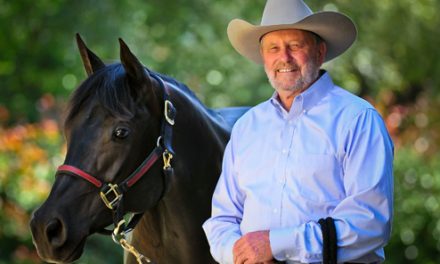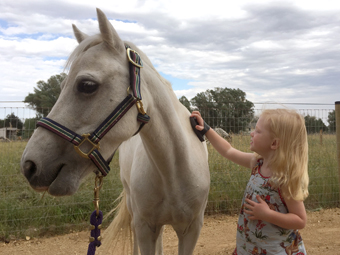 The goal of Trick Horse Training is to create a companion horse that is willing, compliant, intelligent, and has “learned how to learn”. There is one other important element that goes beyond even compliance and that is obedience. In this age of new, natural and gentler horsemanship obedience is not talked about much. But we should talk about obedience because an obedient horse is a safe horse, on the ground and on the trail.
The goal of Trick Horse Training is to create a companion horse that is willing, compliant, intelligent, and has “learned how to learn”. There is one other important element that goes beyond even compliance and that is obedience. In this age of new, natural and gentler horsemanship obedience is not talked about much. But we should talk about obedience because an obedient horse is a safe horse, on the ground and on the trail.
At Imagine a Horse, we specialize in Trick Horse Training as a vehicle to create not only an obedient horse but a willingly obedient horse or in other words, a horse that likes his job.
Pedestal Training will help to create a willing horse that will Step Up, Step Over, Step Around, Step Back on a pedestal but on trail objects and obstacles too.
Almost every species of animal trained by humans is done so with the use of a “place” or a “mark”. This applies to dolphins, big cats, dogs, birds and elephants. If you watch dog agility, you will see up close how effectively the mark is used. The dog returns to his place after completing a trick or series of moves and awaits his next cue. His place is his personal space where he receives praise, a food treat or even a well deserved time out.
In ground training the pedestal gives a horse somewhere to go, rather than to just act out on his flight instinct and run away. Horses have been running away from things for eons and a pedestal gives the horse a place to go to and a place to stay. Quiet feet equal a focused mind. Pedestal work helps to develop physical dexterity while increasing self-confidence and boldness. Ground tying, yielding of the hindquarters and many other useful lessons are taught through pedestal training.
How and Why does pedestal training help to instill willing obedience?
Horses love to stand on pedestals because it makes them taller than usual and taller than other horses, which increases their confidence. Standing with the front feet on a pedestal gets the weight off of the front end and helps a horse to stretch and relax his back which makes him feel good. A relaxed and confident horse is in a mind set to learn.
Many of the requests made of horses in standard training surely seem nebulous from their perspective. Take for example yielding the hind quarters-why does a horse respond to that request in ground work? He responds because he is given a release of pressure (that is applied by the handler) for responding correctly to the request and over time, the response becomes automatic.
Let’s take the release of pressure a step further-What if a horse were to receive not only a release of pressure but also a degree of self (intrinsic) reward or satisfaction? That’s exactly what the usual outcome of pedestal training is.
With his front feet anchored on a pedestal, it is easy for the horse to understand yielding the hind quarters because he has a reason for his front feet to stay still.
In pedestal training as we will demonstrate, the trick becomes the reward.
Goals of pedestal training include having the horse mount the pedestal with two feet and then all four feet as directed. He should stand quietly until released. He should go to any pedestal as cued while at liberty (no lead).
Benefits
A horse becomes willing to stand quietly. His attention span is increased as he learns to focus on the handler and await the next cue. His physical dexterity is increased especially in variations of pedestal work such as having all four feet up and when pivoting his hind quarters around the front. He learns to pay attention to what both ends of his body are doing. When he is on a small square pedestal with all four feet, it automatically creates lift of the top line and of the stomach muscles which will be helpful in creating collection under saddle.
Tips before you start
Teach your horse to move and/or lift each foot (all 4) separately when cued. The horse should have good ground manners such as stopping, stepping back and yielding each part of his body when asked.
Be prepared to prevent your horse’s evasions. For example, if he comes over the top of the pedestal, place it against a wall or fence. Be as creative with problem solving as the horse is with evasions.
Each horse learns at an individual pace. It may take a horse many repetitions or even days of repetitions before he has enough confidence to step up with both front feet. Teaching is a process, give your horse the necessary number of repetitions required but also know when to stop teaching each lesson.
For mounting with two feet approach the wide (oblong pedestal) side of the pedestal every time so that the horse associates that side with the specific reason of mounting with the front feet. For mounting later on with four feet, it will be easier to approach the narrow end so the horse has room to “walk up”.
Pedestals can be constructed in any dimension desired. The standard pedestals that we suggest starting with are a 20” x 48” rectangular shape and a 36” x 36”square top. Heights can be from 12” to 15”. Variations on construction styles include Revolving Top Pedestals and Multi-tiered or stair step pedestals and agility platforms. You may email the authors for construction specifications of pedestals at suesmonet@aol.com
If your horse is a draft breed or a mini, you may want to modify the size of the pedestal to accommodate her size. A good way to estimate the height of pedestal your horse requires is to use the measurement from the middle of his knee to the ground.
Pedestal or Stumps and Rocks on the Trail?
Stepping a horse up on a stump or large rock on the trail is a great exercise however it is not pedestal training. One of the most valuable pedestal exercises is to be able to send the horse to a pedestal, any particular pedestal that the handler desires which is a demonstration of willing obedience. Pedestals can be positioned and used to benefit the lesson being taught and immobile objects in a field can not be.
Pedestal Safety
As in all equine activities, caution is important. Horses do not usually slip on the pedestal but precautions are still advised. Above all, know your horse and begin pedestal training with good ground manners. The construction of the pedestal is important. The sloped sides, rubber mat cushioned top and heavy duty design are all safety features. Square box shaped pedestals are NOT safe for horses beyond two months of age!
Here’s how to teach it
Teach the horse to step up on a pedestal with the front feet first. We’ll cover mounting with all four feet and other variations (including the revolving pedestal) in later segments.
At first you may want to walk next to the horse as you approach the pedestal and later when lungeing him, you can position yourself on the opposite side of the pedestal. During the first session (or two) it may be enough for a shy horse to just approach the pedestal and lift his foot as cued.
Approach the pedestal with the horse in hand and cue him to lift his front leg. It may be necessary at first to actually lift his foot forward and up to help him to place it on the pedestal. A horse must willingly give his foot when asked to facilitate this. If he does not lift his leg, tap him on the fetlock with the end of a whip. Offering the foot willingly should be a behavior that is instilled in the horse before beginning Pedestal Training. You may experiment with the handle of a dressage length whip or the snap to see which works best. As with all good horsemanship, strive to use the mildest effective cue for the individual horse. A harder cue does not mean increased or quicker results and can scare the horse.
When he allows you to place his foot on the pedestal, be sure to praise him and stroke his leg while encouraging him to keep it there. Repeat this step until the horse is comfortable with putting his foot “Up” and will do it freely when asked. When he will reliably put one foot on the pedestal, begin to encourage him to step up with the other foot by helping him to shift his balance off of the foot on the ground so it is easily lifted. Use the lead rope (short hold) to guide him as you ask him to “Step Up” by gently pulling his nose over the leg already on the pedestal. After he will willingly step up with both front feet, encourage him to stay for incrementally longer periods of time and until he is released. You may also condition him to stay on the pedestal as you step back from him and also walk around. This is similar to the stay command in dog training and the beginning step of ground tying. The complimentary and opposite part of this lesson is to teach him to “Step Down” on cue.
When a horse understands how to Step Up with both front feet, lungeing him to it adds a sense of urgency (on his part) to go to the pedestal. This is the applied pressure portion of the lesson and the point at which stepping up on the pedestal will offer the release or reward. Use a long working line (approx 15 feet) to lunge the horse around the pedestal. Lunge him around the pedestal at a trot. As he approaches the wide side of the pedestal, draw his head toward it by shortening the line and slipping it through your hands. As you do this, give him a preparatory cue such as “ready” then ask him to “Step Up”. The preparatory cue lets the horse know that a request is coming. Most horses understand in short order that stepping up and standing still is much easier than trotting circles. It is at this point that a horse usually comes to understand that he has some control over his work routine-he can STEP UP and rest. When he mounts the pedestal, praise him and a food treat may be used also. Let him know that he did just what you wanted. Now the trick will have become the reward.
The horse is empowered because he can make the choice for release of pressure by stepping up which lets him willingly make the right choice. When he is on the pedestal, he will focus on the handler because it is easier than going back to trotting circles, which is exactly what we want. When he looks away or loses his focus or steps down before released, put him immediately back to trotting circles. Do this as a directive with absolutely no emotion attached. In other words, we school with no emotion but praise with all our heart!
Opposite and Complimentary Lesson
Teach the horse a cue for dismounting the pedestal such as “Step Down”. He is to dismount the pedestal only when cued to do so. If he does dismount before he is released, send him back to work trotting circles for a few laps and try again.
Creative Challenges
When a horse is mounted on the square top pedestal with his front feet, ask him to yield the hindquarters or Step Around as his front feet remain anchored. Gradually increase the number of lateral steps until he can completely circle the hindquarters around the pedestal. With his front feet anchored on the pedestal, the request will be easy for him to understand. He can be taught to step the front feet down and walk them around the hind end that is on the pedestal. Revolving pedestals, multi-tiered pedestals and agility platforms present lots of fun challenges.
As the pedestal training progresses, it can serve as a horse’s mark for executing other moves such as the Jambette or Salute, Retrieving an Object, and even a slow Spin. If two horses are worked together, they can be taught to Change Places in a musical chair fashion or to line up side by side on pedestals.
As with all good training, horsemanship principles, tact, good judgment, and a systematic approach are required with reasonable expectations in mind. Taking time to plan will make your sessions fun and fruitful for both horse and human.
Training Instructions
The training instructions contained herein are well researched and have been practically applied to many horses but they are not intended to be absolutes. Be ready, willing and able to practice what we call RIF, Rapid Intelligent Failure. Simply put this means, if something isn’t working be quick to recognize it and change the approach.
For help with Pedestal Training or any other aspects of Equine Agility and Enlightened Trick Training, feel free to contact us at www.redhorseranch.net or www.imagineahorse.com.
If you will email the authors they will email construction directions for pedestals complete with picture.




